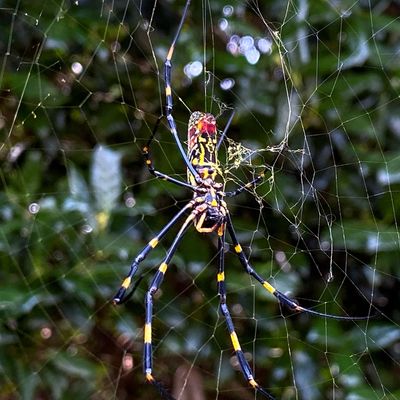
There’s no gentle way to break this news, so I will simply say sorry to those of you living on the East Coast: We are about to be under siege by giant invasive spiders. This according to The Guardian, which reports that the Jorō spider (which “can measure up to three inches when fully extended”!) looks poised to expand its dominion from Georgia to cover the entire eastern seaboard. It’s not the future any of us wanted, but maybe it is the one we deserve.
So a bit about our new neighbors: Jorō spiders — or Trichonephila clavata if you love nomenclature — originally come from Southeast Asia but traveled to the southeastern United States about ten years ago, probably on a shipping container. Per CNN, they have only “two modes of transportation,” aside from skittering around on their unnecessarily long legs, presumably. They can do “ballooning,” wherein hatchlings spin little silk threads to sort of hang glide through the air, though this allows them to go only a few miles. For longer distances, such as across whole oceans, they are likely latching on to a larger vehicle. CNN offers this unsettling factoid via Benjamin Frick, co-author of the recent study sounding an alarm for the Jorō’s allegedly imminent spread: “The reality of the situation … is that for every spider that we might see being transported, there are likely ten more that evade detection.” Cool, thanks!
When the time comes, you will know the Jorō spider not only for its distinctive coloring (blue, yellow, and red bands and stripes) but also for its arresting size. Mere seconds ago, I indicated that the upper limit on length was three inches, but that was just to ease you in. CNN reports that, actually, these spooky guys can grow up to four inches, or “about the size of the palm of your hand or larger.” Females skew bigger than males and have more beautiful coloring, so at least there’s that. Apparently, people also call Jorōs “golden-orb weavers” because they spin geometric webs from golden thread, which, last year, they reportedly used to “cloak the north Georgia woods” in wheeled silk. (“Up to three meters deep,” warns The Guardian.) I think we must assume they will continue this behavior as they migrate north into colder climes, something they can do because of their impressive metabolism and high heart rate. The cold would kill lesser arachnids but, haha, not these.
The study does not provide a precise timeline for the spider’s sprawl, but it does suggest that its “future invasion potential” is robust. Admittedly, there do not seem to be many ecological downsides to their inevitable takeover, and surely you will be relieved to learn that they probably can’t poison you with their venom because their teeth are too small to puncture human skin. All things considered, maybe we’d better resign ourselves to our fate. “People should try to learn to live with them,” another of the study’s co-authors and an Odum School of Ecology research scientist, Andy Davis, told The Guardian. “If they’re literally in your way, I can see taking a web down and moving them to the side, but they’re just going to be back next year.”
Somehow I’m not surprised.


